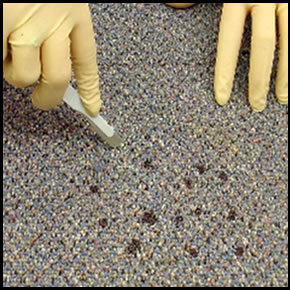Archival Notice
This is an archive page that is no longer being updated. It may contain outdated information and links may no longer function as originally intended.
Home | Glossary | Resources | Help | Contact Us | Course Map
Blood and Body Fluid Collection
The most common methods used to collect blood and body fluid evidence include the following:
- Cuttings. Remove a section of the item containing the stain using a sterile or clean cutting device.
- Wet absorption. A sterile swab, gauze pad or threads slightly moistened with distilled water. Concentrate the stain in a localized portion of the swab or pad. When a swab is used, the stain should be concentrated on the tip. The collection medium is pressed or rubbed into the stain and allowed to air-dry. Some laboratories recommend following the first moistened swabbing with a second dry swabbing to ensure thorough sample collection. Both swabs are retained and submitted for analysis.
- Scraping method. The sample in the video below is scraped with a clean razor blade or scalpel, into a clean piece of paper that can be folded and packaged in a paper envelope. This is a method to be used in a controlled environment (i.e., no wind or traffic) and where the scrapings will not contaminate other evidence." with this text "Scraping method. The sample is scraped with a clean razor blade or scalpel, into a clean piece of paper that can be folded and packaged in a paper envelope. This is a method to be used in a controlled environment (i.e., no wind or traffic) and where the scrapings will not contaminate other evidence. This method is rarely used on scene.
Open and save a double sided printable version of bindle paper.
See the YouTube Terms of Service and Google Privacy Policy
- Tape-Lifting method. An optional method for collecting dried blood stains on a nonabsorbent surface is using fingerprint tape. The fingerprint-lifting tape may be placed over the stain and lifted off. The stain is transferred to the adhesive side of the tape, which may then be secured on a clear piece of acetate for submission to the laboratory. Note: When using this method, the collector must ensure the fingerprint tape is not contaminated with other biological materials.
Additional Online Courses
- What Every First Responding Officer Should Know About DNA Evidence
- Collecting DNA Evidence at Property Crime Scenes
- DNA – A Prosecutor’s Practice Notebook
- Crime Scene and DNA Basics
- Laboratory Safety Programs
- DNA Amplification
- Population Genetics and Statistics
- Non-STR DNA Markers: SNPs, Y-STRs, LCN and mtDNA
- Firearms Examiner Training
- Forensic DNA Education for Law Enforcement Decisionmakers
- What Every Investigator and Evidence Technician Should Know About DNA Evidence
- Principles of Forensic DNA for Officers of the Court
- Law 101: Legal Guide for the Forensic Expert
- Laboratory Orientation and Testing of Body Fluids and Tissues
- DNA Extraction and Quantitation
- STR Data Analysis and Interpretation
- Communication Skills, Report Writing, and Courtroom Testimony
- Español for Law Enforcement
- Amplified DNA Product Separation for Forensic Analysts


